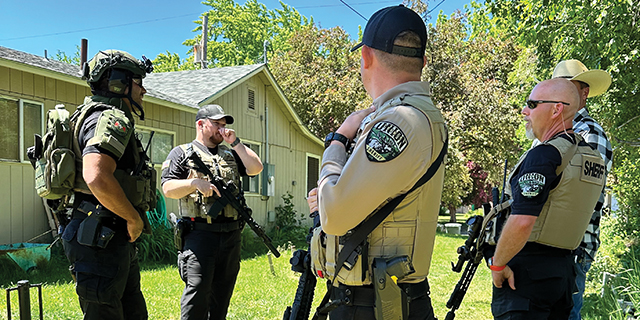Out and About: Ladd Marsh from above — no plane (or jetpack) required
Published 9:08 am Friday, June 28, 2024

- Jacoby
If you’ve wondered what Ladd Marsh looks like from above but lack access to an aircraft, hot air balloon or jetpack, there is another option.
You don’t even need to leave the ground.
(Or try to find a jetpack.)
But you will still have to tussle with gravity.
The Grande Ronde Valley is ringed with mountains, of course.
But the Glass Hill Unit, at the west side of Ladd Marsh Wildlife Area, is both easily accessible and the chunk of elevated terrain nearest the wetlands that sprawl between Interstate 84 and Foothill Road.
A hiking trail that starts just off Foothill Road climbs the steep eastern slope of Glass Hill, giving hikers a fair approximation of an aerial view.
It’s a true panorama, the vista expanding the higher you ascend, taking in much of the valley along with Mount Emily, Mount Fanny and the snow-streaked tips of the high Wallowas capping the eastern horizon.
I walked the trail — much of it actually on an old road — on a Wednesday evening, June 19, and it was just me and the mosquitoes.
(I brought repellent, but so long as I kept moving at a brisk pace the bugs kept their proboscises to themselves.)
This hike is a compelling mixture of the wild and the civilized.
A place where the view simultaneously includes a ponderosa pine, a mountain peak and a convoy of 18-wheelers.
Where the caws of crows compete with the hum of traffic on the busiest road in Northeastern Oregon.
But as I gained elevation the freeway quickly diminished to irrelevance, much as the annoyances of a typical day’s toil do when you enter the refuge of home.
The trail starts beside the parking lot at the White Barn, a distinctive structure just west of Foothill Road.
The trailhead, which includes a restroom, is about 4 miles south of Gekeler Lane and about 1.7 miles from Interstate 84 at the Foothill Road exit.
The parking lot is open year-round, but the Glass Hill Unit, which includes the trail, is open April 1 through Jan. 31. The trail is open to hikers and horseback riders only. A parking permit from the Oregon Department of Fish and Wildlife, which manages Ladd Marsh, is required. Permits are available at ODFW offices, and they’re also included if you buy an Oregon hunting license.
ODFW also asks visitors to fill out a form — they’re available in a brown metal box at the trailhead.
The trail climbs from the start, heading straight up the hill to the west, a sort of tunnel through a field of grass taller than I am. After several hundred yards the trail reaches a junction. Turn left, and continue uphill on the old road.
The road ascends steadily but the grade is not severe.
Although the route is on an east-facing slope that’s exposed to the sun for much of the day, the pines, and their welcome shade, become more numerous the higher you climb.
About 50 yards from the junction with the trail and the road, and just before the road crosses a small stream, a narrow trail branches off to the right, heading more steeply uphill to the west.
This trail continues to a 4,413-foot summit.
The road grade is much more gentle, although unrelenting.
This sort of road fascinates me.
As I walk past tall cutbanks I wonder how many decades ago a bulldozer went about its clanging, clattering business here, gouging a route through the basaltic andesite volcanic rock that makes up this mountain.
On the day of my hike, one day before the solstice, the slopes were surely near the peak of their seasonal lushness, an eruption of chlorophyll in its many shades of green.
That backdrop was interspersed with other colors — the yellow of cinquefoil, which blooms profusely, the pale pink of wild roses, the rich purple of lupine.
As the road climbs — the trailhead elevation is about 2,740 feet and the road rises well above 4,000 feet — the forest thickens, and Douglas-firs join the predominant ponderosa.
With dusk coming on, I turned around after about 2 miles. The road continues to the top of the ridge, nearly 2,000 feet above the trailhead.
On the way down I enjoyed watching the westering sun glint off roofs in Cove, and light softening with the arrival of what photographers call the “golden hour” before sunset.
It would also be a fine place to watch a sunrise.
So long as you don’t give the mosquitoes a stationary target.





